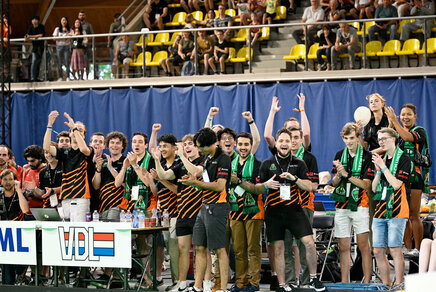Engineering porous electrodes for redox flow batteries
Maxime van der Heijden defended her PhD thesis at the Department of Chemical Engineering and Chemistry on December 6th.
![[Translate to English:] [Translate to English:]](https://assets.w3.tue.nl/w/fileadmin/_processed_/3/0/csm_van_der_Heijden_Maxime%20Banner%20image_2e471e8e6b.jpg)
A major challenge for the world of the 21st century is the development of sustainable energy storage systems on a global scale to bridge the gaps between energy demand and supply. Electrochemical technologies have emerged as one of the most promising energy storage systems by enabling clean, versatile, and adaptable storage of sustainable, but intermittent energy sources. To meet the rising demand for such systems, radical innovations in science and engineering are needed to increase cost competitiveness. In her PhD research, Maxime van der Heijden looked at one type of rechargeable system – redox flow batteries – with a specific focus on ways to make such batteries more efficient.
Redox flow batteries are rechargeable systems in which electrolyte solutions stored in external tanks are pumped through an electrochemical stack where the redox active species dissolved in the electrolyte undergo electrochemical reactions to charge and discharge the battery.
This type of battery is promising for large-scale energy storage as the stack and tank sizes can be independently scaled, they facilitate long operation lifetimes, are inherently safe, and have high round-trip efficiency.
Yet, the high costs, low energy density, and suboptimal performance of the battery have limited their market penetration. And for her PhD research, Maxime van der Heijden aimed to address these limitations by working on ways to improve the design of the porous electrodes in such batteries.
Porous electrode engineering
Redox flow batteries contain porous electrodes that determine the device's performance and costs. These multifunctional materials provide surfaces for electrochemical reactions, facilitate mass transport, as well as conducting electrons and heat.
Currently, conventional porous electrodes are made from fibrous carbonaceous materials developed for low-temperature fuel cells, and as such, their microstructure and surface chemistry are not suited for the requirements of redox flow batteries.
Thus, there is a need for targeted engineering of porous electrodes with tailored properties and great control over the morphology, which is challenging as it requires solving a multivariable optimization problem at different length scales with highly coupled transport and kinetics.
During her PhD work, van der Heijden developed a novel framework to design and synthesize electrode architectures from the bottom-up resulting in highly-controlled microstructures which were tailored to redox flow batteries. She elucidated fundamental structure-function relationships by modeling and imaging commercial electrodes, and she used this knowledge to develop synthetic methods to design hierarchically organized porous electrodes through topology optimization and fabricated them with 3D printing.
Bottom-up design of porous electrodes
Thereafter, van der Heijden developed an open-access pore network modeling framework for flow batteries that is microstructure-informed and electrolyte-agnostic, validated with experimental data, and has a low computational cost.
She then used the model to systematically study the influence of the electrode microstructure, electrolyte chemistry, flow field design, and electrode thickness on the flow cell performance. In a follow-up study, she coupled a genetic algorithm with the pore network model for the bottom-up design of electrode structures.
Using this approach, the electrode microstructure evolves driven by a fitness function that minimizes pumping power requirements and maximizes electrochemical power output. The algorithm is a versatile framework that can also be applied to other electrochemical systems.
Later, she expanded the algorithm through the implementation of commercial electrodes, integrated flow fields, and extended evolutionary freedom during the optimization, so as to make the optimization of commercial electrodes possible under a range of operating conditions and reactor designs.
Towards next-generation porous electrodes
In addition to her simulation work, van der Heijden deployed state-of-the-art imaging techniques and manufacturing methods to better understand the structure-performance relationships in electrode microstructures in connection with flow field geometries.
She developed a new neutron radiography approach to quantify concentration distributions in operando redox flow cells, providing the community with a new diagnostic tool to better understand reactive transport phenomena in electrochemical reactors.
Furthermore, she manufactured model grid structures using stereolithography 3D printing followed by carbonization to tune the physicochemical properties of electrodes by investigating the influence of the printing direction, pillar geometry, and flow field type on the mass transport and hydraulic performance of ordered lattice structures.
Title of PhD thesis: Engineering porous electrodes for redox flow batteries - modeling, diagnostics, and manufacturing. Supervisors: Antoni Forner Cuenca and Zandrie Borneman.
Media contact
Latest news

![[Translate to English:] [Translate to English:]](https://assets.w3.tue.nl/w/fileadmin/_processed_/7/7/csm_Banner%20image%20Woonbedrijf%20-%20Vestide%20-%20Haven%20TUe%20Campus%20-%20Drone-3_4876c53b3c.jpg)
![[Translate to English:] [Translate to English:]](https://assets.w3.tue.nl/w/fileadmin/_processed_/e/e/csm_TUe%20Veni%20Grants%20photos%201920x1080%20px_398dab1f6d.jpg)